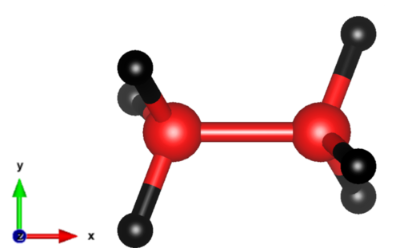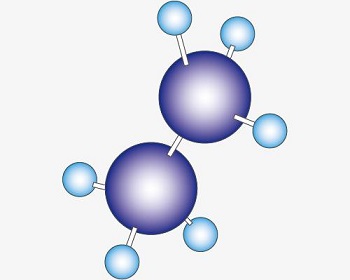エタン 化学特性,用途語,生産方法
定義
本品は、次の化学式で表される炭化水素である。
性質
水に溶けにくく、有機溶媒に溶けやすい性質を持ちます。炭素−水素結合、炭素−炭素結合ともに安定で、反応性は高くありません。酸化剤・還元剤や酸・塩基とはほとんど反応しませんが、光の照射や加熱によって置換反応を起こします。
また、完全燃焼させると、二酸化炭素と水が発生します。
C2H6 + 7/2 O2 → 2 CO2 + 3 H2O

歴史
エタンは、1834年にマイケル・ファラデーによって、水溶液を電気分解することで、初めて合成されました。天然には、1864年にエドモンド・ロナルドによって、ペンシルバニア軽油中にエタンが溶けていることが発見されました。
解説
エタン C2H6(30.07).CH3CH3.脂肪族飽和炭化水素(アルカン)の一つ.石油系炭化水素の分解,改質により発生するガス,および湿性ガス中に含まれる.製法は,上記ガスより分留すると得られる.原子間距離C-C0.157 nm,C-H0.109 nm.∠H-C-H112°.二つのメチル基が重なり形配座よりもねじれ形配座になったほうが約12 kJ mol-1 安定である.引火性の無色,無臭の気体.融点-183.27 ℃,沸点-88.63 ℃.爆発範囲3.2~12.5体積%.化学的活性に乏しく,おもに燃料およびエテンの製造原料として用いられる.[CAS 74-84-0]
森北出版「化学辞典(第2版)
用途
エチレンの原料として石油化学製品の製造に用いられるほか、クロロエチレンなどのハロゲン化合物の製造や燃料としての用途がある。高濃度では麻酔作用がある。エタンの製造はエチレンやアセチレンを、触媒を用いて接触的水素化を行うか、ハロゲン化エチルを還元するが、純粋なエタンの用途は少ない。
製法
現在では、エタンは重要な石油化学原料として、天然ガス中の他の成分から分離される場合がほとんどです。
具体的には、極低温下で液化させることで、効率良くメタンからエタンを分離することができます。ガス状のメタンを取り除き、液体をさらに蒸留することでエタンとより重い炭化水素とを分離することができます。
また、石油精製の副産物として発生する石油ガス(ガス状の炭化水素混合物)からも、エタンを分離することが可能です。
実験室的には、エタンは酢酸塩水溶液の電気分解によって作製します。
2 CH3COONa + 2 H2O → C2H6 + 2 CO2 + H2 + 2 NaOH
化粧品の成分用途
噴射剤
説明
Ethane is a colorless, odorless, flammable gas
that is relatively inactive chemically and is considered
nontoxic. It is shipped as a liquefied
compressed gas under its vapor pressure of 544
psig at 70°F (3750 kPa at 21.1℃).
物理特性
エタン 石油分解ガスや湿性天然ガスに含まれる無色無臭の気体。他のメタン系炭化水素と同じように化学試薬に対して安定であるが,引火性,爆発性がある。沸点-89℃。 800℃では脱水素を起しエチレンとなり,1300℃ではさらに脱水素されアセチレンになる。燃料や石油化学におけるエチレンの製造原料である。
化学的特性
Ethane is a compressed, liquefied, colorless gas. Mild, gasoline-like odor. Odorless when pure.

来歴
Ethane was first synthesized in 1834 by Michael Faraday
(1791–1867) through the electrolysis of acetate solutions, although Faraday believed the
compound was methane. Twenty years later Adolph Wilhelm Hermann Kolbe (1818–1884)
incorrectly identified ethane as the methyl radical in his research, and Edward Frankland
(1825–1899) prepared ethane by treating ethyl iodine (C
2H
5I) with metals.
使用
In the manufacture of chlorinated derivatives; as refrigerant in some two-stage refrigeration systems where relatively low temperatures are produced; as fuel gas (so called "bottled gas" or "suburban propane" contains about 90% propane, 5% ethane, and 5% butane).
調製方法
The synthesis of ethane takes place through a process called Kolbe synthesis. In this processacetic acid (CH
3COOH) undergoes electrolysis to oxidize acetate ions at the anode of an electrochemicalcell to produce acetate radicals: CH
3COO- → CH
3COO?. Two acetate radicals thencombine to give ethane and carbon dioxide: CH
3COO? + CH
3COO? → C
2H
6 + 2CO
2.
定義
A gaseous alkane
obtained either from the gaseous fraction
of crude oil or by the ‘cracking’ of heavier
fractions. Ethane is the second member of
the homologous series of alkanes.
一般的な説明
A colorless odorless gas. ETHANE is easily ignited. The vapors are heavier than air. ETHANE can asphyxiate by the displacement of air. Under prolonged exposure to fire or intense heat the containers may rupture violently and rocket. Contact with the liquid may cause frostbite.
空気と水の反応
Highly flammable.
反応プロフィール
Saturated aliphatic hydrocarbons, such as ETHANE, may be incompatible with strong oxidizing agents like nitric acid. Charring of the hydrocarbon may occur followed by ignition of unreacted hydrocarbon and other nearby combustibles. In other settings, aliphatic saturated hydrocarbons are mostly unreactive. They are not affected by aqueous solutions of acids, alkalis, most oxidizing agents, and most reducing agents. Peroxidizable
危険性
Severe fire risk if exposed to sparks or open
flame. Flammable limits in air 3–12%. An asphyxiant gas.
健康ハザード
Like methane, ethane is a nonpoisonous gas.It is a simple asphyxiate. At high concentrationsit may exhibit narcotic effects.
火災危険
EXTREMELY FLAMMABLE. Will be easily ignited by heat, sparks or flames. Will form explosive mixtures with air. Vapors from liquefied gas are initially heavier than air and spread along ground. CAUTION: Hydrogen (UN1049), Deuterium (UN1957), Hydrogen, refrigerated liquid (UN1966) and METHANE (UN1971) are lighter than air and will rise. Hydrogen and Deuterium fires are difficult to detect since they burn with an invisible flame. Use an alternate method of detection (thermal camera, broom handle, etc.) Vapors may travel to source of ignition and flash back. Cylinders exposed to fire may vent and release flammable gas through pressure relief devices. Containers may explode when heated. Ruptured cylinders may rocket.
使用用途
エタンは様々な化学物質、特にエチレン製造の原材料として利用されます。エチレンは石油化学産業で中間製品として用いられており、そのほとんどは化学繊維や有機化学製品の原料となっています。例えば、ポリエチレン袋、から作られる日用品、衣類、、電線の被覆、水道パイプ、合成ゴムなど身の回りのさまざまな製品の原料として使われています。エチレンガスは、野菜や果物の追熟にも活用されています。
また、エタンは発電用燃料として、単独で、あるいは天然ガスと混合して使用される場合もあります。
材料の用途
Ethane is noncorrosive and may be contained in
installations constructed of any common metals
designed to withstand the pressure involved.
安全性プロファイル
A simple asphyxiant.
See ARGON for properties of simple
asphyxiants. A very dangerous fire hazard
when exposed to heat or flame; can react
vigorously with oxidizing materials.
Moderate explosion hazard when exposed
to flame. To fight fire, stop flow of gas.
Incompatible with chlorine, doxygenyl
tetrafluoroborate, oxidizing materials, heat
or flame. When heated to decomposition it
emits acrid smoke and irritating fumes.
職業ばく露
Ethane is used as a fuel, in making
chemicals or as a freezing agent. The health effects caused
by ethane exposure are much less serious than the fire and
explosion risk posed by this chemical
発がん性
Syrian hamster embryo cells
were exposed in vitro to ethane gas. After exposure, the cells
were removed and assayed for viability and increased sensitivity
to viral transformation. Ethane was determined to be
inactive.
貯蔵
All the precautions required for the safe handling
of any flammable compressed gas must be
observed with ethane. It is important that ignition
sources be kept away from containers, including
situations where leakage could cause
the gas to ignite by such sources as a spark from
a motor. AlI piping and equipment used with
ethane should be grounded.
Ethane should not be stored with cylinders
containing oxygen, chlorine, or other oxidizing
or combustible materials.
合成方法
メタンを原料として直接合成される
輸送方法
UN1035 (compressed gas); UN1961 (refrigerated
liquid): Ethane, Hazard Class: 2.1; Labels: 2.1-Flammable
gas. Cylinders must be transported in a secure upright position, in a well-ventilated truck. Protect cylinder and labels
from physical damage. The owner of the compressed gas
cylinder is the only entity allowed by federal law (49CFR)
to transport and refill them. It is a violation of transportation regulations to refill compressed gas cylinders without
the express written permission of the owner.
純化方法
Ethylene can be removed by passing the gas through a sintered-glass disc into fuming H2SO4 then slowly through a column of charcoal saturated with bromine. Bromine and HBr are removed by passage through firebrick coated with N,N-dimethyl-p-toluidine. The ethane is also passed over KOH pellets (to remove CO2) and dried with Mg(ClO4)2. Further purification is by several distillations of liquified ethane, using a condensing temperature of -195o. Yang and Gant [J Phys Chem 65 1861 1961] treated ethane by standing it for 24hours at room temperature in a steel bomb with activated charcoal treated with bromine. They then immersed the bomb in a Dry-ice/acetone bath and transferred the ethane to an activated charcoal trap cooled in liquid nitrogen. (The charcoal had previously been degassed by pumping for 24hours at 450o.) By allowing the trap to warm slowly, the ethane distils, and only the middle third fraction is kept. Removal of methane is achieved using Linde type 13X molecular sieves (previously degassed by pumping for 24hours at 450o) in a trap which, after cooling in Dry-ice/acetone, is saturated with ethane. After pumping for 10minutes, the ethane is recovered by warming the trap to 25o. (The final gas contains less than 10-4 mole % of either ethylene or methane). [Beilstein 1 IV 108.]
不和合性
Flammable gas; forms explosive mixture
with air. Strong oxidizers may cause fire and explosions.
May accumulate static electrical charges, and may cause
ignition of its vapors.
廃棄物の処理
Return refillable compressed
gas cylinders to supplier. Dissolve or mix the material with
a combustible solvent and burn in a chemical incinerator
equipped with an afterburner and scrubber. All federal,
state, and local environmental regulations must be
observed.
エタン 上流と下流の製品情報
原材料
準備製品